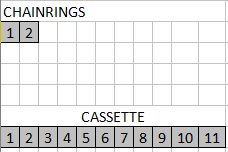Brakes are a critical component of any bicycle, especially on mountain bikes where having a mechanically-sound and reliable set of brakes will ensure that your outings on the trails can be fun, enjoyable and most importantly safe.
Brakes are not only meant to bring you to a stop, but are also used to scrub speed in a controlled manner on technical terrain to allow you to get around corners and over obstacles with precision.
Disc brake pads are the contact points between your brake caliper and your rotor. When you pull the brake lever, hydraulic fluid is pushed (or in the case of mechanical disc brakes, a cable is pulled) which actuates the pistons inside the caliper to come closer together, squeezing the rotor between the pads and producing friction, which is what results in slowing you down.
The more you squeeze the lever, the more friction, and subsequently the more braking power you get.
What are brake pads made of?
Disc brake pads are most commonly comprised of two pieces. The first is the braking surface, which provides the friction necessary to produce brake power, and it is often made out of various compounds, such as sintered, semi-metallic, or organic (resin).
Each compound offers different braking characteristics. The second piece is the backing plate to which the braking surface is bonded. This backing plate is made from a metallic material that has good heat dissipation properties, such as steel or aluminum.
The best mountain bike disc brake pads in 2021
Below we look at some of the best brake pads on the market today.
1. G04Ti Metallic Disc Brake Pads
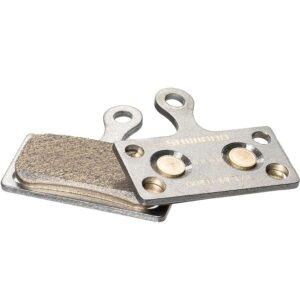
These Shimano disc pads are a direct replacement for two-piston Shimano Deore, SLX, XT, XTR and Alfine brake systems. They have a Titanium backing plate to keep the weight low.
The metallic compounds ensure you will have ample braking power on steep terrain even with heat buildup in the pads and rotors.
2. Shimano J03A Resin Disc Brake Pads
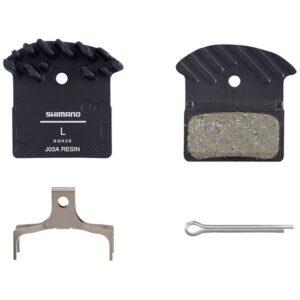
This resin pads from Shimano have “fins” which increase the heat-dissipation properties. The resin compound offers good performance in a variety of conditions.
Compatible with Shimano two-piston brakes like SLX, XT, XTR and others.
3. SRAM Code Disc Brake Pads
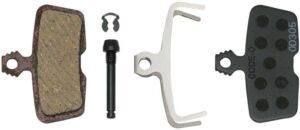
SRAM’s Code disc brakes are a popular option among keen trail riders thanks to their ample power provided by their four-piston calipers and excellent modulation.
These factory replacement pads come with an organic compound and steel backing for good all-around braking performance.
4. SwissStop EXOTherm2 Brake Pads
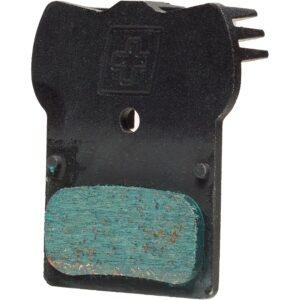
SwissStop is a company known for innovative and high-quality brake components, and their brake pad offerings are among the best in the market.
The EXOTherm2 come in wide compatibility with various Shimano and SRAM brake models (the one linked is specific to Shimano brake systems).
Cooling fins on the backing plate as well a special compound developed by SwissStop ensure excellent heat-dissipation properties.
5. Jagwire Semi-Metallic Disc Brake Pads for Magura
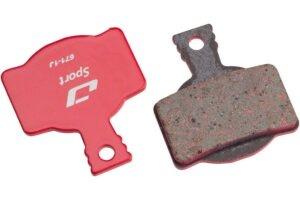
Jagwire is another aftermarket brake parts manufacturer, and they make pads for all major brake brands.
These Jagwire pads are specific to Magura brake models MT8, MT6, MT4, MT2. They come in semi-metallic compound and a steel backing plate.
6. SwissStop Disc RS Brake Pads
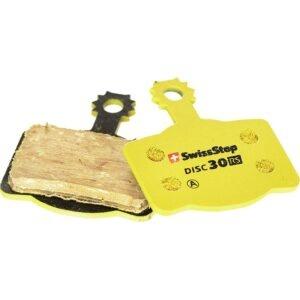
Here is a great aftermarket option for the popular SRAM Guide RS. These brake pads from SwissStop have a braking surface made from a proprietary compound that combines Kevlar, ceramics, resin and brass.
Using this multi-material compound allows SwissStop to optimize and balance the various desirable braking characteristics, such as high braking power, low noise and good modulation.
7. Kool-Stop BB7 Replacement Pads
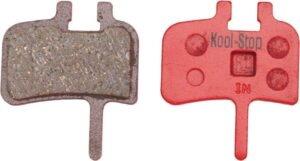
Kool-Stop is another aftermarket brake parts specialist with some excellent brake pad offerings.
These pads from Kool-Stop are a direct replacement for the factory pads for Avid BB7 mechanical mountain bike disc brakes. They come with a steel backing plate and a semi-metallic compound.
8. Tektro P20.11 Disc Brake Pads 
Tektro is a manufacturer of bike brake systems with many excellent and affordable offerings for entry-level and mid-tier bikes.
These pads are a direct replacement for several mountain bike disc brake systems in their product line-up (see compatibility chart). They come with a ceramic compound and metal backing.
9. Magura USA 8.P Disc Brake Pad
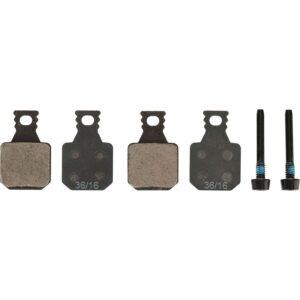
German manufacturer Magura makes some of the best mountain bike brake systems on the market, and their factory brake pads are sometimes hard to find, but offer optimal performance.
These pads are compatible with their MT7 brakes and have a resin and brass compound for good braking performance and better longevity than their “Race” pads.
They’re specifically made for use on enduro and trail mountain bikes, and great for use by recreational riders and racers alike.
10. MTX Braking Red Label Race SRAM G2/Guide Brake Pads

MTX Braking may not be a household name in brakes, but this American brand makes some high-quality aftermarket brake pads.
Their flagship line, called the Red Label offers improved braking power, good modulation and low noise in all conditions.
Things to know before buying your next set of brake pads
Which pad compound to choose?
Sintered pads (metallic) are usually more expensive than other compounds, but offer the best braking power and longevity. Choose this compound if you race your mountain in enduro or downhill events or often ride in wet weather. Sintered compounds do take longer than other compounds to bed in, so keep that in mind if you intend to replace the pads and go out for a ride in a hurry.
Organic pads are great for use in dry conditions and are an affordable option for recreational riders. The bed in period is short, so you achieve maximum braking power quicker than sintered or semi-metallic pads. They’re also the least noisy. The main downsides of organic pads are that they have a short life and perform poorly in wet weather.
They’re prone to contamination and glazing more than other compounds. Choose pads with organic compounds if you are a recreational rider and most of your riding does not involve long high-speed descents or wet weather rides, but you want low-noise, low-vibration pads for your brakes.
Semi-metallic pads combine metallic and organic materials and are a hybrid version of both compounds. They offer good all-around performance in all conditions and decent longevity. They’re not the quietest, not the most powerful and not the cheapest option, but they offer acceptable performance in a variety of riding scenarios and conditions.
Ceramic pads are essentially sintered pads with some ceramic material mixed in. The idea being that the ceramic content should further enhance the heat dissipation characteristics of the pads and offer more consistent braking over long descents in steep terrain, which is important in racing scenarios where heat build-up in the brake system often results in what is known as “brake fade”.
The downside is that the wear rate will be faster than standard sintered pads. If you are a mountain bike racer and downhill braking performance is of utmost importance, ceramic brake pad compounds would be an appropriate choice.
Finned vs Standard backing plates
As you might have noticed from the list of brake pads we featured, some come with “finned” backing plates. This is another feature that some manufacturers add to their pads to help with more effective heat dissipation.
For most recreational riders, this feature will have a negligible effect and the (often cheaper) non-finned pads will do just fine. For downhill riders and enduro racers, the additional cooling effect provided by those fins might be worth the extra cost.
How to ensure you pick pads compatible with your brakes?
Aside from the different compounds to choose from, disc brake calipers accept only the pads designed for them and those come in a wide array of shapes and sizes, which can get a little confusing.
When shopping for replacements, look for the compatibility information listed by either the brake system brand or the aftermarket pad manufacturer.
When to replace your mountain bike brake pads?
Disc brake pads are among the consumable parts on your bike. It is important to keep the pads, as well as other brake components, in good condition and service or replace as needed.
Brake pads should be replaced when braking performance decreases and other issues have been ruled out (e.g. needing a brake line bleed or a dirty brake rotor).
It is critical to replace pads before the braking surface gets completely worn out all the way down to the backing material (as metal-on-metal contact will be detrimental for your rotors), and frequent visual inspection is the easiest way to determine when to replace the pads.
How to replace your brake pads
The specific steps to follow will depend on your specific make and model of your brake system, but you will need some basic tools, such as a good set of hex (Allen) keys, needle nose pliers, pad pusher tool or large flathead screwdriver and a solvent or brake-safe cleaning spray.
When in doubt or if you don’t feel comfortable working on your bike, it is always best to take your bike to your local bike shop.
Conclusion
Brake pads are a critical component for a well-functioning mountain bike disc brake system.
Replacing your pads in a timely manner, choosing the right pad compound for your riding style and preferences and staying on top of periodic maintenance of your brake system will ensure that you have a reliable and trouble-free braking performance that you can count on the rowdiest of trail rides.

Hani Morsi is a seasoned multi-discipline cyclist with a particular liking for mountain and gravel bikes. Hani is also a mountain bike coach, trail builder and experienced bike mechanic.



